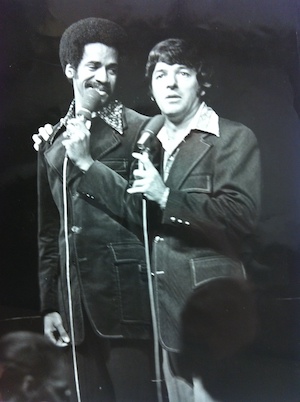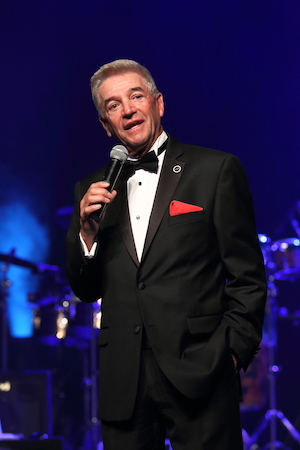
Lifting himself out of poverty by his own bootstraps, Tom Dreesen made it to the very pinnacle of standup comedy by staying in touch with his humble roots.
Tom Dreesen grew up in a shack with no hot water, started working at age 10 and, as a young comedian, slept in a car for three weeks. In that very same lifetime, he appeared on “The Tonight Show” more than 60 times and spent 13 years riding in private jets and limousines as the opening act for Frank Sinatra.
Like the Sinatra song “My Way,” Dreesen — who is half Irish and half Italian — has had his share of ups and downs, starting with a rough-and-tumble childhood in Harvey, Illinois, a working-class town where his family barely clung to the short end of the stick.
“It’s hard to describe how poor we were, but I’ll try,” Dreesen said from his home in Southern California. “Our home was rat and roach infested. We had no bathtub or shower. For heat, we would gather the little pieces of coal that fell off the train in a box.”
Dreesen spent his childhood defending himself against neighborhood tough guys and listening to his parents, who both had drinking problems, argue until dawn. He would then get up, deliver newspapers and go to school. He found stability by joining the U.S. Navy at 17. His service led him to exotic ports around the world, where he gained life experience but no trade or profession. Instead, he returned to Harvey and worked odd jobs, from bartender to dock foreman to insurance salesman.

As a release, he joined the Jaycees, where he met Tim Reid, who would later find national stardom as Venus Flytrap on “WKRP in Cincinnati.” Dreesen and Reid began their long friendship doing middle school drug prevention presentations that were filled with give-and-take and lighthearted banter. Those evolved into gigs at local clubs, and the two men became “Tim and Tom,” the first black/white comedy team.
They toured the country together, working college campuses and the black “chitlin circuit” between long stints at Playboy clubs around the country. But after six years, there was no “big break,” and the team broke up. Dreesen could have returned to the Chicago area and made a good living selling insurance, but his life so far — the good, the bad, the poor, the funny — was a story he needed to tell. So with no money in the bank, one suit and a dream, he left for Los Angeles.
Sleeping in an abandoned car, washing up in a nearby gas station and living on a dollar a day for food, Dreesen would distribute headshots to agents during the day and wait for the Comedy Store to open its doors in the evening.
Producers would attend sets there in search of talent, with the holy grail being an appearance on “The Tonight Show Starring Johnny Carson.” It’s where superstars like David Letterman, Robin Williams and Jay Leno got their start, but at that time, they were all struggling for a break. After hundreds of sets at the Comedy Store, Dreesen was the first of that legendary lot to finally be invited onto “The Tonight Show.” The audience loved him.
Beyond his infectious personality and boyish good looks, Dreesen’s life experiences fueled comedy that every working person could relate to. After seeing him perform, Sammy Davis Jr. invited Dreesen to open for him. He then toured with Liza Minelli, Natalie Cole, Frankie Avalon, Smokey Robinson and others. That journey inevitably led him to the late, great Frank Sinatra.
The story goes that Dreesen attended a Sinatra show at Harrah’s Hotel right after his own performances at Caesars Palace in Lake Tahoe. The manager of Harrah’s introduced him to Sinatra’s manager, Mickey Rudin, suggesting that Dreesen would be a good opening act. Rudin asked, “Hey, kid, if I gave you a week with Frank Sinatra, would you want more than 50,000 a week?” Dreesen replied, “If you give me a week with Frank, would YOU want more than 50,000?”
The rest, as they say, is history. Sinatra discovered that he had much in common with the young comic. Both came from hardscrabble backgrounds, growing up in saloons. Frank’s father was a boxer, and Dreesen boxed while in the Navy. Both were passionate supporters of the civil rights movement, and both were Italian.
That part of Dreesen’s identity came as a surprise. As a child, he assumed he was a combination of Dutch, German and Irish, but he always felt comfortable at the Italian churches and carnivals he attended in Harvey and nearby Blue Island. He also felt close to his uncle, Frank Polizzi, his mother’s sister’s husband.
“I was 13 when I began to realize that I didn’t look like my brothers. They had blonde hair and blue eyes. But I looked just like my uncle, Frank, and his two sons. They had black hair and brown eyes,” Dreesen says. “So when I was 15, we went for a walk. I always felt very comfortable with him, so I told him, ‘I think I’m your son.’ He told me, ‘Yes, it’s true. I am your father. And you can tell the world about it, but it would ruin your mom and dad’s marriage, and it would ruin mine.’”
 Sinatra was one of the few people to whom Dreesen privately related the story. Upon hearing it, Sinatra told him, “That kind of thing happens more than you know.”
Sinatra was one of the few people to whom Dreesen privately related the story. Upon hearing it, Sinatra told him, “That kind of thing happens more than you know.”
As time went on, the bond between the two men grew stronger. Dreesen often stayed at Sinatra’s palatial home, where he mingled well into the morning hours with guests like Gregory Peck, Kirk Douglas, Robert Wagner and Clint Eastwood. Then, it was off on Sinatra’s private jet to open for the megastar in front of as many as 40,000 people.
As Frank aged, Dreesen became more than an opening act; he was a vital part of his support system. When Sinatra died in 1995, Dreesen was honored that Sinatra’s wife, Barbara, asked him to be one of the pallbearers and to speak at his funeral. But it was also the end of an era for him.
“The day I met him, my life forever changed,” Dreesen says. “The day he passed away, I knew my life would never be the same.”
After Sinatra’s passing, Dreesen continued to perform his standup routines across the country and appeared on shows like “Late Night with David Letterman.” Dreesen also showed up in Eastwood’s film “Trouble with the Curve” and has co-written “Tim and Tom,” a book about his days working with Reid, and his autobiography, “Still Standing: My Journey From Streets and Saloons to the Stage and Sinatra.” Outside of the spotlight, he has worked tirelessly for several charities, most notably raising funds to fight multiple sclerosis and to help disadvantaged children.
“I look where I came from and pray every night, realizing how grateful I am to make a living as a standup comic and entertainer,” Dreesen says. “In this way, my prayers have been answered, and the least I can do is to give back so that maybe someday the dreams of some young person can come true, as well.”
The above appears in the November 2022 issue of the print version of Fra Noi. Our gorgeous, monthly magazine contains a veritable feast of news and views, profiles and features, entertainment and culture. To subscribe, click here.
 Fra Noi Embrace Your Inner Italian
Fra Noi Embrace Your Inner Italian






